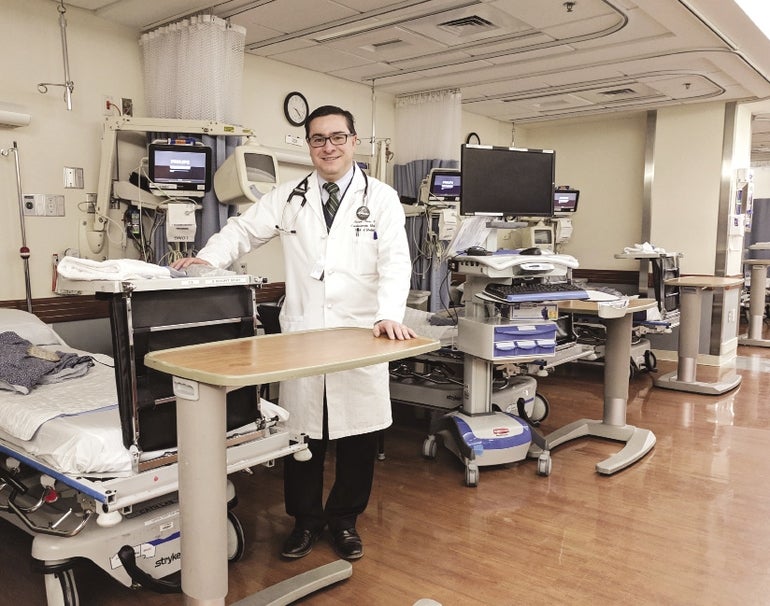Dr. Alvaro Alonso was completing his residency at Tufts Medical Center in Boston when he and his colleagues spotted something peculiar.
Alonso, now a cardiologist at UMass Memorial Medical Center in Worcester, noticed how many people from the surrounding Chinatown neighborhood would come in complaining of dizziness. It became infamous among staff.
There was a reason, and it had nothing to do with their physical ailments. Those Asian patients had no word for dizziness in their native language and were trying to say they were feeling ill, Alonso said.
Only later did doctors discover the misunderstanding.
Alonso’s story is one of many illustrating how providing health care has become more complicated with a more diverse population. Challenges with language barriers are only a part of it.
As the population in and around Worcester has diversified in recent decades, health care has changed with it. New ethnic and racial groups have various health needs, with the differences caused by still largely unknown factors.
Addressing cultural needs & stigmas
A few generations ago, the city was overwhelmingly white. Immigrants came from places like Ireland, Canada and Britain. These days, the city’s largest immigrant populations are from Brazil, Vietnam, Ghana and the Dominican Republic, according to U.S. Census data. Roughly a quarter of the city’s population is foreign-born.
Some of those areas of the world carry higher rates for certain conditions.
South Asians have a diabetes rate four times higher than Caucasians, for example, according to a study last year by the University of California Irvine.
“It’s well established that certain groups have a higher incidence of cardiovascular disease,” Alonso said.
A larger African population, particularly West Africa, has brought to the Worcester area men with a much higher prevalence of prostate cancer, said Dr. Mitchell Sokoloff, a urologist at UMass Memorial Medical Center.
“It’s a major health disparity issue in the Worcester area,” Sokoloff said.
Hereditary factors aren’t the only concern for doctors.
Other cultures can have different views of preventative care. African men, for instance, are particularly reluctant to get early screenings for prostate cancer despite their higher prevalence rates, Sokoloff said.
Anne Fine, the vice president of behavioral health at the Worcester agency YOU Inc., has seen a lag in some populations to mental health stigmas that otherwise have lessened.
“The value placed on treatment and the value of mental health services still varies greatly across cultures,” she said.
At Community Healthlink, Dr. Jennifer Bradford, who works with a largely homeless population, has found stigmas around mental health to lead to some patients not wanting to acknowledge an illness, nevermind taking prescription drugs for it. Others may prefer to turn to a clergy member or take other routes not involving modern Western medicine or psychotherapy.
Social determinants
Such factors add a newer element to what the medical community calls social determinants for health. Those factors, which have been known for far longer in health care, include potential causes for more health issues, such as lower incomes and educational attainment, access to housing and transportation, and social support.
Ethnicity also has a role.
Asians, for example, were found to have better health overall than the general population, and Hispanics and blacks worse, according to a 2016 study by the Kaiser Family Foundation of California. Black adults were found to have higher HIV rates, and Native Americans had higher rates of alcohol or drug dependence or abuse.
Black and Hispanic populations are less likely to have health coverage, according to the Census.
At Saint Vincent Hospital, Chief Medical Officer Dr. Sowmya Viswanathan has adjusted proactive screening to better account for both genetic factors and a relunctance from some to go to the doctor.
“Culturally, some feel that to go to the doctor means ‘I have a problem’ and they don’t want to admit they have a problem,” she said.
Understanding the nature of the problem
A growing awareness and acknowledgement of racial and ethnic factors has not come with any conclusions for what exactly causes them. Local doctors and those who’ve studied the topic have pointed to the harmful effects of immigrants adopting high-fat American diets or not knowing where to turn for health care – or being able to afford it – when adjusting to a new life here.
The American Heart Association and others issued new guidelines last November calling ethnicity a risk factor for U.S. populations for the first time.
With a growing awareness, treating a patient can be far different today.
Among religious differences, Orthodox Jews and Jehovah’s Witnesses are known for particular views on health procedures such as an avoidance of blood transfusions. As for variations among countries, UMass Medical School has a resource guide for important differences doctors should know before treating patients from countries with larger populations here.
“You have to be prepared and open and compassionate and see the world from their belief system,” said Naheed Usmani, a pediatric doctor at UMass.
Language remains a strong factor.
Of the 10 largest immigrant groups in Worcester, only Ghaniaians speak English as their primary language. At the Family Health Center of Worcester, the staff is able to speak more than 50 languages to talk with patients.
Doctors describe language barriers as both time consuming and complicating. Patients are most comfortable expressing their feelings in their own language, Fine said.
“It’s really hard to express what they need to express in a secondary language,” she said.

